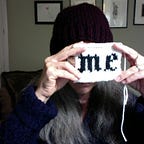What COVID-19 is teaching me about teaching
It’s 8:55 am Monday. I’ve got Bill Withers’ “Lovely Day” playing on Spotify, and a glass jar of water and a mug of lukewarm tea at my left. WebEx is launched and dunning me to download the app even though the program is running on my desktop. I’m presentably-enough-dressed waist-up and in sweats waist-down. I begin the session muted and video off, and lurk as my design students arrive. K and A always arrive video on. The others, video off. A flurry of greetings in the chat. The College’s clock tower clock dingdongs the hour and we begin.
What has COVID-19 taught me about teaching?
1. To save more trees. Everything is created, critiqued and delivered on-screen. We squint to discern if type size works in an International Typographic Style-influenced print layout by doing the math: counting characters and spaces per column, points of leading vs. point size of running text.
2. To leave my ego at the door. Will I ever learn to turn my mic back on when I stop sharing my screen? Likely not. When I’m multitasking (i.e. navigating while speaking) I speak more slowly and deliberately. I hope the effect’s not soporific.
3. That being a digital native doesn’t guarantee that someone’s going to be an effective online learner or instructor.
4a. That we’re all in this together. Our moods fluctuate. We’re isolated. Some of us are in quarantine. Many could use a hug.
4b. Some students just need a nice lasagna. One of my colleagues cooked for her students and sat outside our building handing out Tupperware containers of food. I wish I’d thought of this.
5a. That we are sometimes–coincidentally–one big organism. Some days most of us show up coiffed. Other days most of us are unkempt. Some days no one wants to be seen. Some days pets appear. I am always on camera. They’re on as they see fit. Everyone talks, whether audibly or in the chat.
5b. It’s OK for students to be off camera. A colleague related that one of their students habitually goes on-camera despite a roommate visible in the bunk bed in the background. Oysh … TMI.
6. To use more than one channel at a time. So different from the seated studio, in which audible speaking is the only way to communicate. The chat is really lively during critiques, and when students enter and leave the session.
7. Effective right-sizing: The whole group’s best if everyone needs to know the same everything at the same time. We do our large group work at the beginning of class. Small groups analyzing and commenting on the same piece on-screen in crit: perfect.
8. Teaching online led me to make my course content more accessible to the students. It’s “pushed” live and can be “pulled” later on demand. All slides, urls, and references are available 24/7 on our course blog. This hasn’t had a negative impact on attendance. And it seems to relieve student anxieties about catching up or not completely grasping a concept or technique.
9. Increased course content accessibility means a more organized me. Until COVID-19 I was the queen of redesigning classes every semester. Now I have several units worth of presentations ready for future reference and improvement.
10. I’m much more conscious of scaffolding, of sussing out my teaching from the student pov. Warm-up research, fewer projects, slower projects, detailed feedback. Doing their part, students actively solicit feedback on the course blog and are honest and supportive in critiquing their peers.
It’s 3:20 pm Monday. Two back-to-back sessions have come to a close. In the old days, teaching in person left me mostly energized (and sometimes demoralized, when a class didn’t go well). Now online, any high is tempered by my feeling drained and irritable afterwards. I wear bluelight glasses and turn the computer off for the day when I’m done teaching. I’m hyper and tired, and unfit for everything else.
But I guess that’s ok because I’m not doing much of anything else.
Hoping we all stay well and in good spirits.
